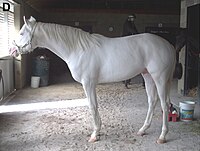
Photo from wikipedia
In this study, toxicity caused by 50, 100 and 200 mg/kg b.w doses of Paraquat herbicide in Swiss albino mice was investigated. Body weight, liver and kidney organ weights, aspartate… Click to show full abstract
In this study, toxicity caused by 50, 100 and 200 mg/kg b.w doses of Paraquat herbicide in Swiss albino mice was investigated. Body weight, liver and kidney organ weights, aspartate aminotransferase (AST) and alanine aminotransferase (ALT) enzyme activities, blood urea nitrogen (BUN) and creatinine levels, malondialdehyde (MDA) and glutathione (GSH) levels in liver and kidney, micronucleus (MN) formation in buccal mucosal epithelium, erythrocyte and leukocyte cells and chromosomal aberrations (CAs) in bone marrow cells, viability of liver and kidney cells were investigated. Four groups were randomly formed from male Swiss albino mice (one control and three treatment groups). The control group mice were provided tap water and the mice in the treatment groups were treated orally with three different doses of Paraquat (50, 100 and 200 mg/kg b.w) in the drinking water for 28 days. At the end of the application, all mice were sacrificed and routine preparation procedures were carried out to examine physiological, biochemical, oxidative stress and genetic parameters. Paraquat administration decreased physiological parameters (body, liver and kidney organ weights), and increased biochemical parameters (AST, ALT, BUN, creatinine and MDA). GSH levels were decreased depending on the dose. Kidney and liver damage were confirmed by the trypan blue test. Paraquat administration promoted MN formation in buccal mucosal epithelium, erythrocyte and leukocyte cells depending on the dose. The highest MN frequency was observed in leukocyte cells exposed to a dose of 200 mg/kg b.w of Paraquat. Deteriorations in DNA integrity as a result of MN formations were supported by the comet assay. In addition, Paraquat promoted CAs such as break, fragment, acentric, dicentric, gap and ring in bone marrow cells. Break damage was the most common among these damages. These observed genotoxic effects occured as a result of the interaction of DNA and DNA-related proteins with Paraquat. Molecular docking studies showed that Paraquat binds to histone H4 protein with high affinity and has a high intercalation potential. As a result, Paraquat herbicide caused a significant toxicity by changing physiological, biochemical, oxidative stress and genetic parameters of Swiss albino mice depending on the application dose.
Journal Title: Scientific Reports
Year Published: 2022
Link to full text (if available)
Share on Social Media: Sign Up to like & get
recommendations!